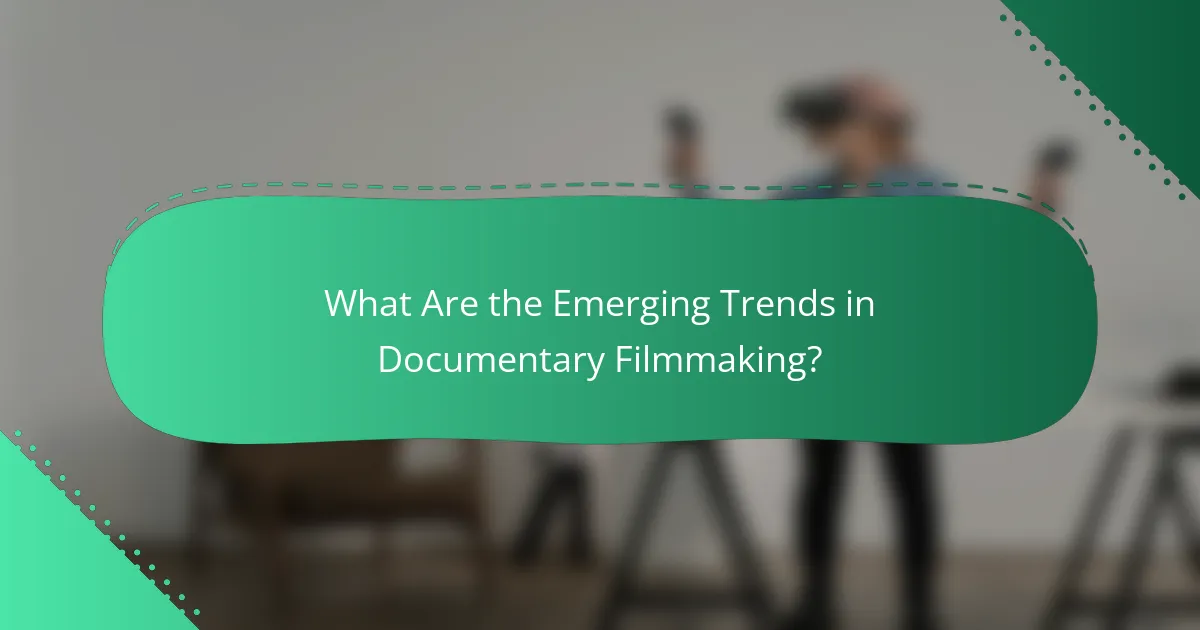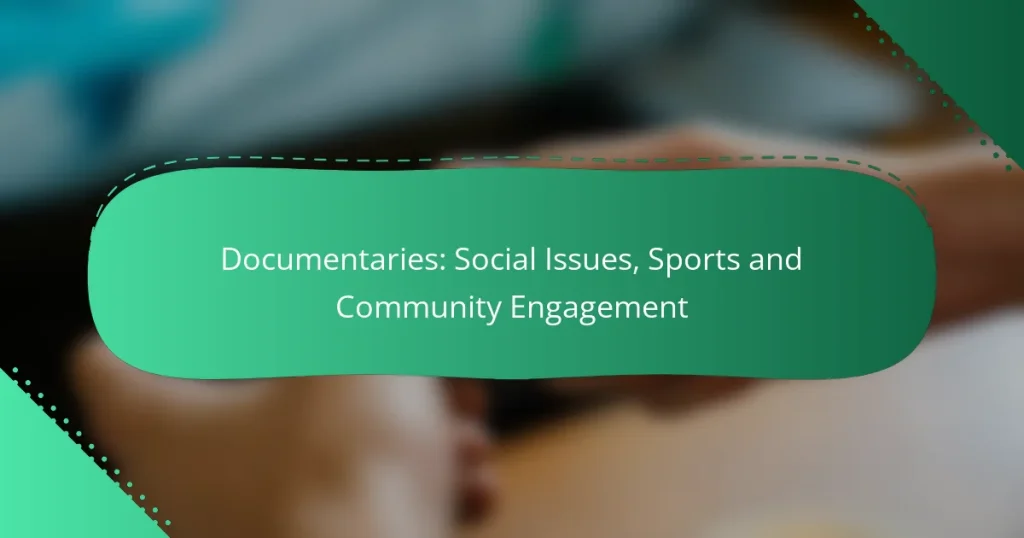Documentaries serve as a vital medium for exploring social issues, sports, and community engagement, offering viewers a window into real-life stories that illuminate the challenges and triumphs faced by individuals and groups. Through compelling narratives and visual storytelling, these films not only inform but also inspire action, fostering a deeper understanding of the societal dynamics at play. By highlighting the intersection of sports and culture, they reveal the profound impact athletics can have on communities, encouraging collective engagement and mobilization for change.

How Do Documentaries Address Social Issues?
Documentaries tackle social issues by presenting real-life stories and data that highlight challenges faced by communities. They aim to inform viewers and inspire action through compelling narratives and visual storytelling.
Impact on public awareness
Documentaries significantly raise public awareness about pressing social issues by providing in-depth analysis and personal perspectives. They often reach audiences who may not be familiar with these topics, effectively broadening the conversation.
For example, films like “13th” and “Food, Inc.” have sparked discussions on systemic racism and food production, respectively, leading to increased public scrutiny and advocacy for change.
Case studies of successful documentaries
Several documentaries have successfully influenced social change. “The Act of Killing” challenged perceptions of genocide in Indonesia, prompting international dialogue and reflection on historical injustices.
Another notable example is “Blackfish,” which raised awareness about the treatment of orcas in captivity, resulting in policy changes for marine parks and a decline in attendance at such facilities.
Role of filmmakers in advocacy
Filmmakers often take on the role of advocates, using their platforms to promote social justice and community engagement. They can leverage their influence to mobilize viewers and encourage them to participate in activism.
Many filmmakers collaborate with NGOs and grassroots organizations to ensure their documentaries not only inform but also drive actionable change, creating a bridge between storytelling and real-world impact.

What Are the Best Documentaries on Sports?
The best documentaries on sports provide in-depth insights into the lives of athletes, the dynamics of competition, and the cultural impact of sports. These films often highlight significant events, personal stories, and the broader societal issues intertwined with athletic pursuits.
Top-rated sports documentaries
Some of the top-rated sports documentaries include “The Last Dance,” which chronicles Michael Jordan’s career and the Chicago Bulls’ dynasty, and “Free Solo,” showcasing rock climber Alex Honnold’s daring ascent of El Capitan. Other notable mentions are “Icarus,” which explores doping in sports, and “Senna,” a tribute to the legendary Formula One driver Ayrton Senna.
These documentaries are acclaimed for their storytelling, cinematography, and ability to engage audiences emotionally while providing a deeper understanding of the sports world.
Influence on sports culture
Sports documentaries significantly influence sports culture by shaping public perceptions and sparking conversations around important issues. They often highlight themes such as perseverance, teamwork, and social justice, encouraging viewers to reflect on the values and ethics of sports.
For instance, “The Battered Bastards of Baseball” sheds light on the independent baseball league and challenges the norms of professional sports, while “When We Were Kings” revisits the iconic Rumble in the Jungle, emphasizing the cultural impact of boxing beyond the ring.
Documentaries that changed perceptions
Several documentaries have changed perceptions about athletes and sports. “Beyond the Mat” provides a behind-the-scenes look at professional wrestling, revealing the struggles and realities faced by wrestlers, which has shifted how fans view the industry.
Similarly, “The Two Escobars” intertwines the stories of soccer player Andrés Escobar and drug lord Pablo Escobar, challenging viewers to consider the intersection of sports and crime in Colombia. These films encourage audiences to think critically about the narratives surrounding sports figures and the societal contexts in which they operate.

How Do Documentaries Foster Community Engagement?
Documentaries foster community engagement by raising awareness about social issues and inspiring collective action. They serve as powerful tools for storytelling, allowing communities to connect over shared experiences and mobilize for change.
Examples of community-focused documentaries
Several documentaries highlight community issues and drive engagement. Films like “Won’t You Be My Neighbor?” explore the impact of public figures on local communities, while “13th” addresses systemic racism and its effects on society. These films not only inform viewers but also encourage discussions and actions within communities.
Other notable examples include “The Social Dilemma,” which examines the effects of social media on society, and “The Act of Killing,” which invites communities to confront historical injustices. Each documentary serves as a catalyst for dialogue and community involvement.
Impact on local initiatives
Documentaries can significantly impact local initiatives by bringing attention to specific issues and inspiring grassroots movements. For instance, a documentary highlighting food deserts can lead to community gardens or farmers’ markets, improving access to fresh produce.
Moreover, these films often spark fundraising efforts or volunteer opportunities, allowing community members to contribute directly to the causes they care about. This engagement can lead to sustainable changes and stronger community ties.
Collaborations with grassroots organizations
Many documentaries collaborate with grassroots organizations to amplify their messages and reach wider audiences. These partnerships can provide essential resources and support for local initiatives, enhancing the documentary’s impact.
For example, a film focusing on environmental issues might partner with local conservation groups to organize clean-up events or educational workshops. Such collaborations not only strengthen community engagement but also ensure that the documentary’s themes resonate with local audiences.

What Criteria Should You Consider When Choosing Documentaries?
When selecting documentaries, consider their relevance to current social issues, the credibility of the filmmakers, and viewer ratings and reviews. These factors can significantly influence the impact and quality of the documentary experience.
Relevance to current social issues
Documentaries that address pressing social issues tend to resonate more with viewers and can inspire action or awareness. Look for films that tackle topics like climate change, social justice, or community health, as these are often timely and impactful.
Consider how the documentary frames the issue. Does it provide diverse perspectives or focus on a specific community? Engaging with relevant themes can enhance your understanding and connection to the subject matter.
Filmmaker credibility
The credibility of the filmmaker plays a crucial role in the documentary’s reliability. Research the filmmaker’s background, previous works, and any affiliations they may have. Established filmmakers often bring a wealth of experience and a track record of quality storytelling.
Look for documentaries produced by recognized organizations or those that have received awards. This can indicate a level of professionalism and commitment to factual accuracy, which is essential for sensitive topics.
Viewer ratings and reviews
Checking viewer ratings and reviews can provide insight into the documentary’s reception and overall quality. Platforms like IMDb or Rotten Tomatoes can help gauge public opinion and highlight potential strengths or weaknesses.
Pay attention to both the quantity and quality of reviews. A documentary with a high rating and numerous positive reviews is likely to be worth your time, while a film with mixed feedback may warrant further investigation before viewing.

How to Create a Documentary on Social Issues?
Creating a documentary on social issues involves thorough research, storytelling, and a clear vision to highlight the topic’s significance. It requires understanding the social context, engaging with communities, and presenting compelling narratives that resonate with viewers.
Steps in documentary production
The documentary production process typically includes several key steps: pre-production, production, and post-production. During pre-production, filmmakers should conduct research, develop a script or outline, and plan interviews and locations. Production involves filming interviews, b-roll footage, and gathering sound, while post-production focuses on editing, sound design, and finalizing the documentary.
It’s crucial to maintain flexibility throughout these stages, as unexpected challenges may arise. For example, a planned interview may fall through, requiring filmmakers to adapt their approach or seek alternative subjects. Keeping an open line of communication with your team and subjects can help navigate these hurdles effectively.
Essential tools and software
Filmmakers need a variety of tools and software to create a documentary. Essential equipment includes a good quality camera, microphones, lighting kits, and stabilization gear. For editing, software like Adobe Premiere Pro, Final Cut Pro, or DaVinci Resolve is commonly used to assemble footage and enhance audio.
Additionally, consider using project management tools like Trello or Asana to keep track of tasks and deadlines. These tools help streamline the production process, ensuring that all team members are aligned and aware of their responsibilities.
Funding options for filmmakers
Funding a documentary can come from various sources, including grants, crowdfunding, and sponsorships. Many organizations offer grants specifically for social issue documentaries, such as the Sundance Institute or the National Endowment for the Arts. Researching these opportunities can provide substantial financial support.
Crowdfunding platforms like Kickstarter or Indiegogo allow filmmakers to raise funds directly from their audience. This approach not only provides financial backing but also builds an engaged community around the documentary. When seeking sponsorships, consider partnering with organizations that align with your documentary’s themes, as they may be willing to provide financial or promotional support.

What Are the Emerging Trends in Documentary Filmmaking?
Emerging trends in documentary filmmaking include a shift towards interactive storytelling and the integration of social media platforms for broader engagement. Filmmakers are increasingly using technology to create immersive experiences that allow audiences to participate in the narrative.
Use of interactive storytelling
Interactive storytelling in documentaries allows viewers to engage with the content in a more personal and immersive way. This approach often includes elements like branching narratives, where choices made by the audience can influence the direction of the story.
Filmmakers can utilize platforms such as websites or apps to create these interactive experiences, enabling audiences to explore different facets of a social issue or community topic. For example, a documentary on climate change might allow viewers to choose which aspect of the issue they want to learn about, such as its impact on agriculture or urban areas.
When implementing interactive storytelling, it’s crucial to maintain a balance between engagement and clarity. Overly complex interactions can detract from the documentary’s message. Filmmakers should focus on user-friendly designs that enhance understanding without overwhelming the audience.


